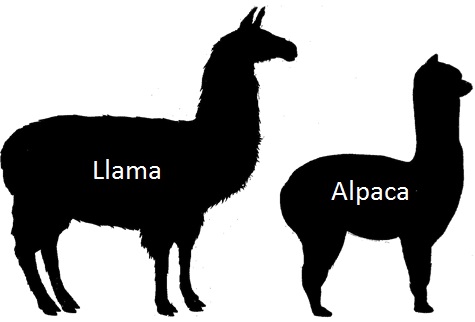- Alpacas are members of the Camelid family and closely related to the Llama.
- Both originate from South America (as did camels).
- Llamas (the donkeys of South America) are bred as pack animals, used for carrying heavy loads.
- Alpacas (the sheep of South America) are bred for their fine fleece, which was highly valued by the Incas.
- Four species of Camelid are found in South America:
- Alpacas are found mainly in Peru, but also in Bolivia and Chile.
- Alpacas and Llamas are domesticated animals.
- Both are now bred all over the world.
- They are descended from the wild Vicuna and Guanaco, which are both now protected species.
- The Vicuna is the National Animal of Peru, and has one of the finest fleeces of any animal on earth.
- Alpacas and Llamas can interbreed.
- Alpacas were first domesticated by the Incas, 6 to 7 thousand years ago.
- Their fleece was so fine that it was reserved for clothing for the elite.
- When the Spaniards invaded South America they killed most of the alpacas.
- Incas fled to the high mountain plains with the surviving alpacas, which then interbred with llamas.
- Preserved fleece fragments have shown that the Inca’s alpacas had a finer fleece than alpacas have today.
- Modern-day breeding programmes are striving to return the fleece quality to what it once was.
- A baby alpaca is called a cria.
- The gestation period of an alpaca is approximately 11½ months, but can often vary by more than a month.
- So far our longest pregnancy at Petlake was 394 days (about 13 months) and our shortest was 328 days (just under 11 months).
- Most newborn cria weigh 7 to 9 kilos. Our heaviest was 10.3 kilos. Our lightest was just over 5 kilos (and has grown to be one of our best females).
- Cria will usually walk and feed within an hour or being born and it's important that they feed within 6 hours.
- We’ve seen one of our own cria stand and feed in less than 3 minutes.
- There are two distinct types of alpaca, huacaya (pronounced wa-kaya) and suri.
- Huacaya have dense crimpy fleece.
- Suri have long lustrous fleece, that looks like dreadlocks.
- Huacaya are shorn every year, ideally just before the warm weather starts.
- Suri are typically shorn every other year.
- We currently just breed haucaya alpacas at Petlake
- Alpacas are very friendly, inquisitive animals.
- Each alpaca has its own distinct personality.
- Like llamas, alpacas have three modes of defense:
- Kicking
- Spitting
- Running away.
- Some of our alpacas will allow you to touch them, or even give them a hug.
- All alpacas tend to be ‘head shy’. This is a defense mechanism to prevent you from blocking their airways or impairing their vision or hearing.

